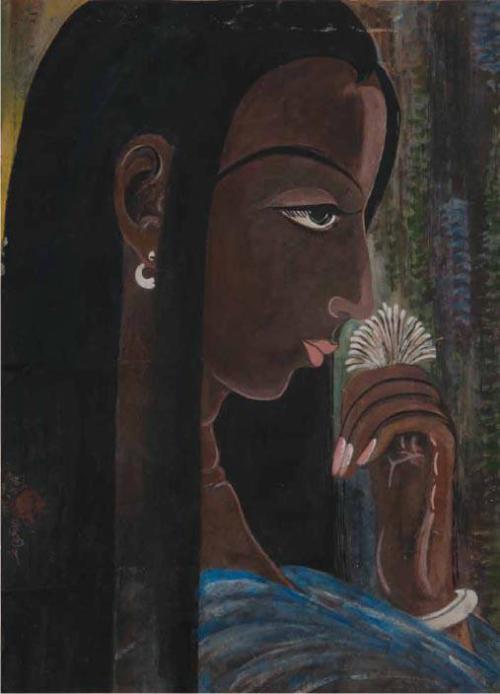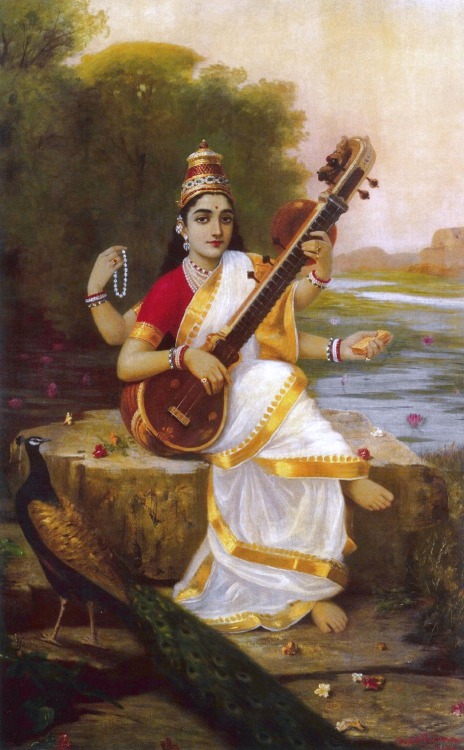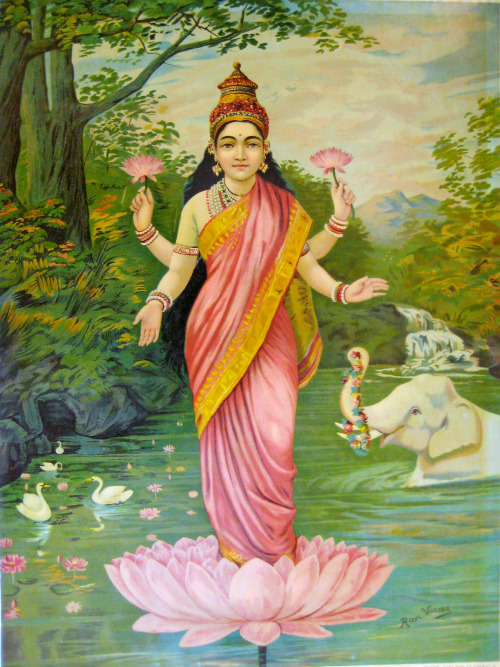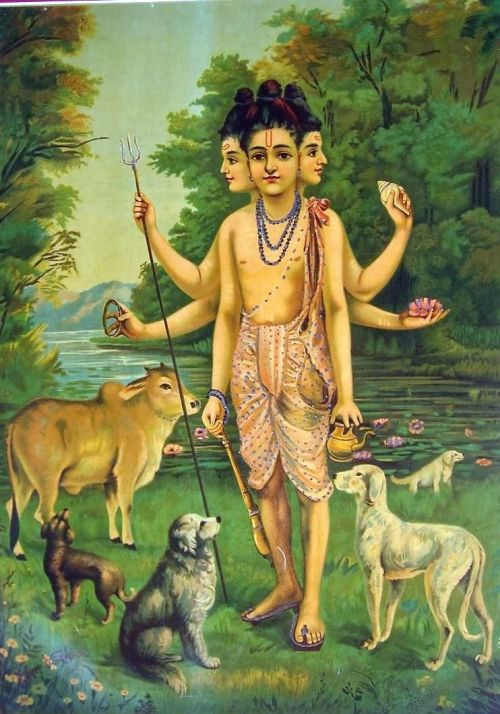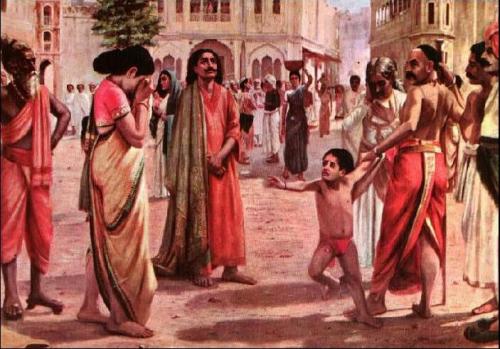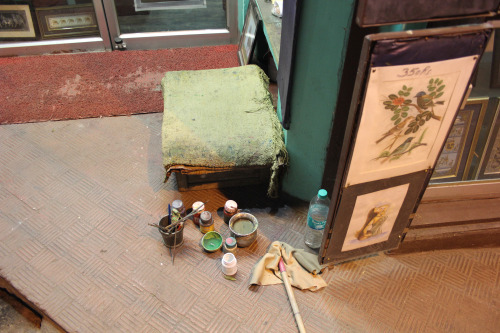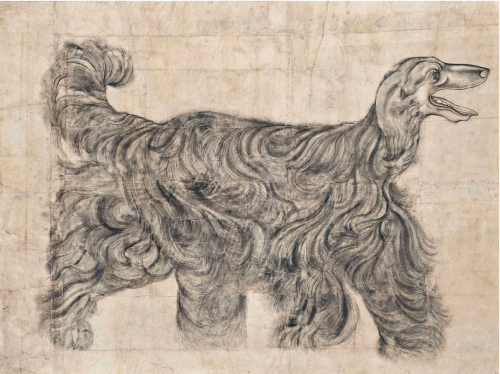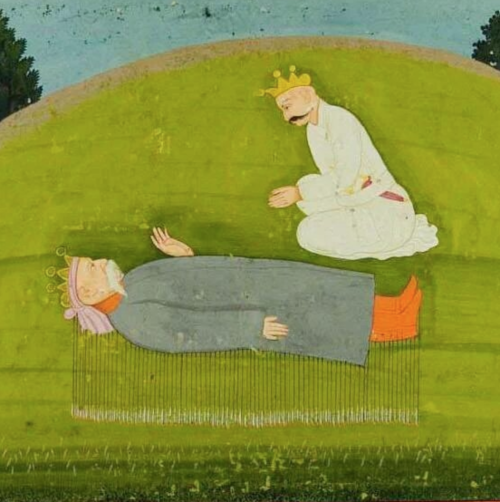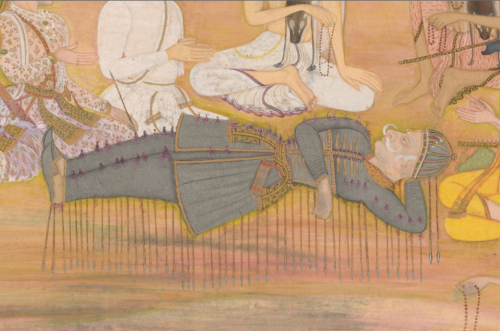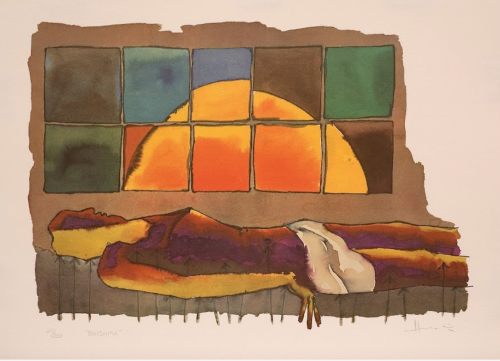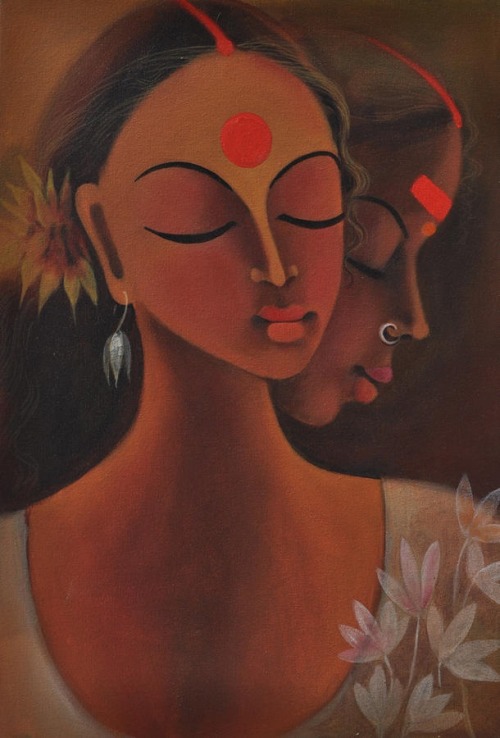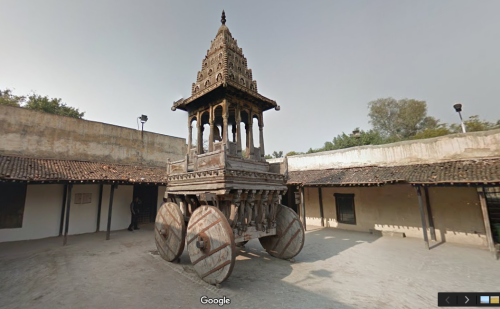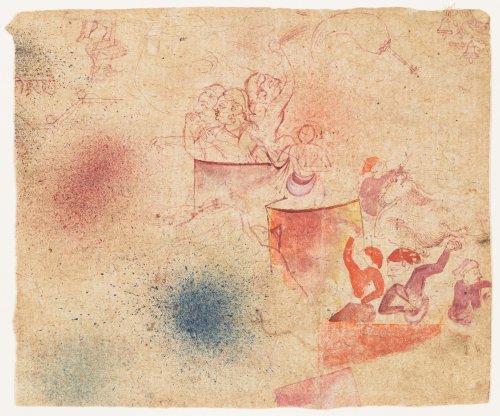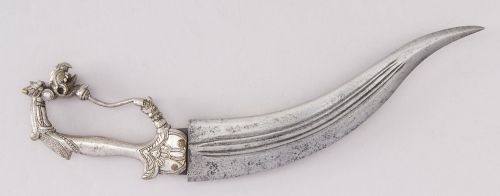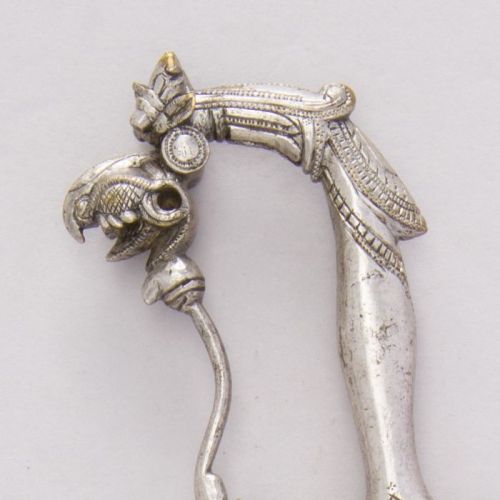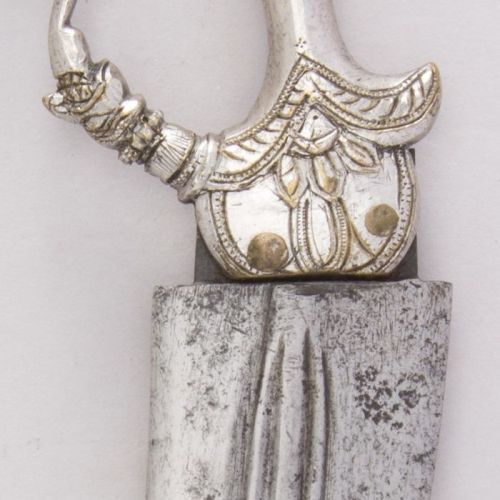#indian art
A Music Party
Abanindranath Tagore
Bengal, India, 1905
Watercolors on paper
A group of people sit and listen to a lady playing a sitar. The setting is that of a Mughal court, with Mughal style architecture in the background and the setting sun visible through the arches.
The artist, Abanindranath Tagore (1871 - 1951) was the pioneer and leading exponent of the Bengal School of Art, which flourished between 1905 and 1920. In his paintings, he sought to counter the influence of Western art as taught in art schools under the British Raj, by modernizing indigenous Moghul and Rajput traditions. His work became so influential that it was eventually accepted and regarded as a national Indian style.
Post link
Nur Jahan
India, Mughal, c. 18th century
Opaque watercolors & gold on paper
© Victoria & Albert Museum
Post link
A Camel and it’s Rider Playing Kettledrums
Mazar Ali Khan
Delhi, India, Mughal, c. 1840
Gouache
© Victoria & Albert Museum, London
One of six figures, this painting likely depicts the Mughal Emperor’s ceremonial procession on the occasion of Eid.
Post link
Perpetual Beauty (Raja Ravi Varma)
“Raja Ravi Varma was an Indian painter and artist, considered as one of the greatest painters in the history of Indian art. Raja Ravi Varma is known for his amazing paintings, which revolve mainly around the Puranas (ancient mythological stories) and thegreat Indian epics - Mahabharata and Ramayana. Ravi Varma is one of the few painters who managed to accomplish a beautiful union of Indian traditionwith the techniques of European academic art. This is one of the reasons why he is considered as one of the most, if not the most prominent Indian painters. Varma was also responsible in taking the Indian art all over the world with his impeccable technique. While the Europeans and other art lovers admired his technique, the laymen of India enjoyed his work for its simplicity. More often than not, Varma’s paintings highlighted the beauty of South Indian women which were admired by all.
His portrayal of Hindu gods and goddesses went on to become worship material for many people belonging to the lower castes. Back then, these people were often forbidden from entering temples and thus they celebrated Varma’s works, for they gave them an idea of how the deities looked inside the temple. He also managed to improve the artistic knowledge and spread the importance of art among Indian people. He achieved this by making affordable lithographs, which were accessible even to the poor. Alternatively, this also made him a household name and Raja Ravi Varma soon captured the hearts of all. Recognizing his feat, Viceroy Lord Curzon honored him with the Kaisar-i-Hind Gold Medal for his service in thefurtherance of public interest.“
Selected Works:
1. Nair woman
2. Galaxy of Musicians
3. Lady playing Swarbat
4. Kerala lady playing Swarbat
5. Saraswati
6. Lakshmi
7. Dhana Narayana
8. Dattatreya
9. Harishchandra
10. Victory of Meghanada
Post link
“An impressive portrait of an Afghan Hound”, Probably Rajasthan, Probably Kota, 19th Century.
Post link
- Kṛṣṇa and the Pandavas visiting the dying Bhishma from the epic Razmnameh. Mughal, by Ram Das, c.1598.
- Razm-nama, last hours of Bhisma, talking to Yudhisthira, by Husain ‘Ali, opaque watercolour and gold on paper, Mughal, 1598
- Bhishma on the deathbed, 1750, Folio from a smaller Mahabharata Series, Manaku and his workshop.
- Death of Bhīṣma, from a Mahābhārata]. Kishangarh, Rajasthan, India, ca. 1775.
- Bhisma felled in battle, an illustration to the Mahabharata, India, Pahari, first half 19th century
- Bhishma Pitamaha on arrow bed, Rajasthan, 18th century
- Bed of Arrows (Bhishma), Gaganendranath Tagore, 1922-25.
- Untitled (Bhishma), M.F. Husain, 1970s
- Bhishma - 10th Day Kurukshetra
- Bhishma, M.F. Husain, 1983
- Mahabharata, M.F. Husain 1990
Post link
Let go of the mind and see the light that shines.
Inspired by the wonderful Sephoric Shades.
Artist Sean Kitt:
Post link

“A Gathering of Court Women", Folio from the Davis Album Object Name: Illustrated album leaf Date: late 17th–early 18th century Geography: India Culture: Islamic Medium: Ink, opaque watercolor, and gold on paper Dimensions: 13.12 in. high 8.25 in. wide (33.3 cm high 21 cm wide) Classification: Codices Credit Line: Theodore M. Davis Collection, Bequest of Theodore M. Davis, 1915 Accession Number: 30.95.174.27 Metropolitan Museum of Art

Madonna and Child in a Domestic Interior Artist: Painting by Manohar (active ca. 1582–1624) Object Name: Illustrated single work Date: early 17th century Geography: India Culture: Islamic Medium: Black and colored ink and gold on paper Dimensions: OveralL. 9 9/16 x 5 13/16in. (24.3 x 14.8cm) Dimensions of blue frame: 2 15/16 x 2 1/4in. (7.5 x 5.7cm) Dimensions of painting: 5 ¾ x 3 5/16in. (14.6 x 8.4cm) Classification: Codices Credit Line: Rogers Fund, 1970 Accession Number: 1970.217, Metropolitan Museum of Art
Howl’s Moving Castle but make it Indian
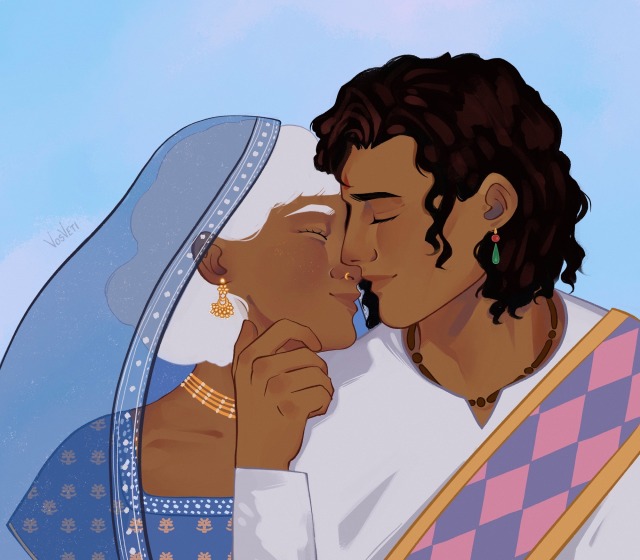

Eid al-Fitr

Happy Eid al-Fitr to everyone celebrating!
Eid al-Fitr translates to ‘the festival of breaking the fast’, and commemorates the end of Ramadan, during which Muslims fast between sunrise and sunset and reflect on their faith. After this month of this sacrifice and dedication, Eid is a time to come together and celebrate with family and friends - though it will likely look slightly different this year due to Covid restrictions.
This 19th-century gouache painting from India shows people rejoicing at the end of #Ramadan
National Handicraft and Handlooms Museum is ethnographic space in New Delhi where craftsmen from various parts of India come in to work towards preservation of various traditional arts and crafts. Today the museum holds over 35,000 rare and distinctive pieces reflecting the continuing tradition of Indian craftsmen through painting, embroidery, textiles, various crafts of clay, stone and wood
Post link
Mahasundari Devi was an accomplished artist who began working on paper in the mid-1960s and was instrumental in fostering women’s crafts in the Madhubani district of Bihar, India. In this painting, she uses a simple, graphic line to depict the mother goddess Parvati with a lotus in one hand honoring her husband Shiva. See this ink painting in our South Asian art galleries. “The Goddess Parvati Honors Her Husband, Shiva,” around 1965–85, by Mahasundari Devi http://ow.ly/cqXV30sfqkw
Post link
Holi is the festival of colors, where celebrants throw brightly colored powders (gulal) at one another while singing and dancing to celebrate the arrival of spring. Here the artist has thrown pigment on the surface of the drawing in a similar spirited manner. Powders were traditionally made from finely ground plants, flowers, fruits, and medicinal herbs such as neem, hibiscus, indigo, beetroot, and turmeric.
“Noblemen on Elephant during Holi Festival,” late 1700s, India
Post link
Kosode with Iris Design and Sarasa Patchwork. Sarasa: India and others, 17th to 19th century, Japan. Bunka Gakuen Costume Museum
I was curious about Sarasa fabric, and I found this article from Japan Times, which had some cool info:
“[Japan] was closed to Portuguese ships in 1639 until 1853. But trade was still carried out with the Dutch and Chinese on the Nagasaki island of Dejima, and relations were established with Korea via the Tsushima region and with China again through the Ryukyu Kingdom (today’s Okinawa). Relations with the Ainu of Northern Japan, meanwhile, went through the Matsumae domain in Hokkaido. These were all windows onto the world….
Sarasa — a geometrically patterned and colorful, often reddish, fabric — was sewn into Japanese clothing and accessories…. It became a major trade item, with the first official record of it entering Japan in 1613; though, ostensibly it had been introduced earlier via the Ryukyu islands, perhaps a century earlier.
Kyoto’s Gion Festival in July still boasts floats displaying tapestries from Belgium (then a part of the Netherlands) and Persian carpets as decorations, all mixed in with sarasa fabrics. Sarasa also featured in Edo Period paintings and was prized for use in the creation of tea-caddy bags, wrapping cloths, and pouches for tea utensils….”
Post link
Chilanum Dagger
- Dated: 17th century
- Culture: Indian, Mahratta
- Medium: Steel, brass, silver, silk
- Measurements: H. 10 5/8 in. (27 cm); H. of blade 7 1/2 in. (19.1 cm); W. 2 11/16 in. (6.8 cm); Wt. 8.1 oz. (229.6 g)
Post link




